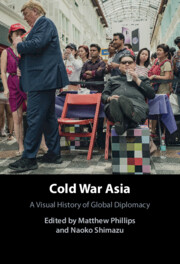Book contents
- Cold War Asia
- Cold War Asia
- Copyright page
- Contents
- Illustrations
- Contributors
- Acknowledgements
- Introduction
- 1 Reframing Non-alignment
- 2 In the Image of Imelda
- 3 Meeting of the Kings
- 4 Conquering the World
- 5 Between Style and Substance
- 6 A Photograph with Two Stories
- 7 Waxwork Wars
- 8 Cosmic Envoy
- 9 A Diplomatic Image and Its Afterlife
- 10 Picturing Power
- Index
2 - In the Image of Imelda
The Surrogate Diplomacy of the First Lady
Published online by Cambridge University Press: 30 January 2025
- Cold War Asia
- Cold War Asia
- Copyright page
- Contents
- Illustrations
- Contributors
- Acknowledgements
- Introduction
- 1 Reframing Non-alignment
- 2 In the Image of Imelda
- 3 Meeting of the Kings
- 4 Conquering the World
- 5 Between Style and Substance
- 6 A Photograph with Two Stories
- 7 Waxwork Wars
- 8 Cosmic Envoy
- 9 A Diplomatic Image and Its Afterlife
- 10 Picturing Power
- Index
Summary
This chapter discusses the role of Imelda Marcos in the diplomatic practice and foreign policy of the government of Ferdinand Marcos. At the outset, Imelda is cast not only as a First Lady but as a vital colleague and co-operator in running the affairs of the Philippine state from the 1960s through the 1980s, the other half of the so-called conjugal dictatorship. At one point in time, she was simultaneously governor of Metro Manila, Minister of Human Settlements, member of the Interim Parliament, and Ambassador Plenipotentiary and Extraordinary. This being said, her status as First Lady and Patroness of the Arts is not dismissed as mere tangent or appendage; it was as First Lady that Imelda became a compelling presence in the political theatre. The combination of her beauty and her charisma formed a particular aesthetic that inevitably evolved into a policy of culture and democracy so central in the formation of a post-independence nation-state in Southeast Asia.
Keywords
- Type
- Chapter
- Information
- Cold War AsiaA Visual History of Global Diplomacy, pp. 47 - 67Publisher: Cambridge University PressPrint publication year: 2025

